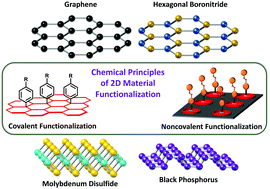Molecular functionalization of 2D materials: from atomically planar 2D architectures to off-plane 3D functional materials
Abstract
In the past 15 years, atomically thin two-dimensional materials (2DMs) have moved from a serendipitously isolated single-layered graphene curiosity to a near technological renaissance, where it is thought that 2DMs such as graphene and transition metal dichalcogenides (TMDCs) will overtake silicon as the fundamental component of future (opto)electronic devices. The remarkable potential of 2DMs is due to their fascinating physicochemical properties that result from their unique electronic structures and atomically precise dimensions. Their (opto)electronic properties can be readily determined by observing their charge-transfer characteristics and by their Raman or photoluminescence spectra. These characteristics, and their underlying electronic structures, can be modified by introducing molecular functionalities to the surface of 2DMs via covalent or non-covalent functionalization ultimately offering a great deal of molecular control over their physicochemical properties. In particular, the ability to modulate the level of doping and charge-carrier density in 2DMs is essential for developing future technologies. Of these two strategies, non-covalent functionalization allows the installation of ancillary molecular functionalities, such as catalytically active metal complexes, light-harvesting antennas, and molecular photo-switches, without disrupting the underlying lattice structure of the 2DM. In this review, we highlight the current state-of-the-art of functionalized 2D materials, including the methods used for obtaining these composite materials. In particular, emphasis will be given to 2D materials that contain molecular photo-switches that are able to reversibly modulate the (opto)electronic properties (e.g., Raman, PL, and charge density) via light-induced isomerization processes. We also discuss the surface-enhancing Raman properties of 2DMs, which have, until now, remained sparsely discussed in the literature. We also discuss the ever-increasing complexity of the self-assembled supramolecular architectures where we are witnessing a transition from planar 2D structures to out-of-plane 3D super structures and the additional advantages they bring.

- This article is part of the themed collection: Journal of Materials Chemistry C Emerging Investigators


 Please wait while we load your content...
Please wait while we load your content...